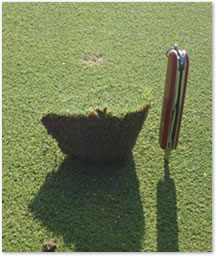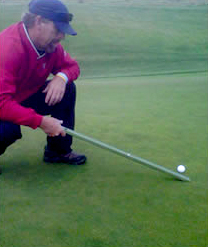I’ve worked in the golf business over 35 years, from being a Golf Course Superintendent, selling fertilizers and control products with The Scott Company to independent consulting with Soil Horizons. This has provided me with a wealth of knowledge in fertilizers, control products, soil amendments, soil and water interpretations and what a Superintendent deals with on a day to day basis.
Superintendent’s responsibilities have changed from the past. Their title is more associated with that of a Project Superintendent. Meetings are more abundant than in the past and more time is spent away from the course. Soil Horizons helps to assist the superintendent to lessen the workload by taking the soil samples, sending them to the lab, interpreting the results, providing unbiased recommendations and a written report on the results. Follow up service is conducted throughout the year at no additional costs. There is no product affiliation with any manufacturer or distributor. We want to make sure the proper fertilizer and soil amending products are applied to not only enhance the health of the soil and plant but to maximize dollars spent. We want to achieve and maintain the proper balance of the soil. It’s a holistic approach in providing the optimal health to the plant and soil.
Soil Horizons not only reviews the soil and water tests (chemical), but the physical and biological characteristics of the soil as well. This helps in determining the extent of cultural practices (aeration, slicing, spiking, verticutting, topdressing etc.) and how to implement these practices to enhance water infiltration and percolation, reduce compaction, stimulate microbial activity, increase soil oxygen levels and improve the playing conditions. Without the proper cultural practices, it limits the effectiveness of nutritional programs.
So if you have any questions or would like a quote for services rendered don’t hesitate calling or emailing. (937) 243-1012.
I look forward in hearing from you.
Rusty Oetker

 What is the importance of soil testing? It provides information necessary for selection of the correct fertilizers and soil amendments. It eliminates all of the guesswork and allows the Superintendent in getting the most efficient use of the products being applied, which will also save money. Why apply a nutrient or nutrients that are not deficient? With budgets being stagnant it is vital to stretch dollars are far as possible!
What is the importance of soil testing? It provides information necessary for selection of the correct fertilizers and soil amendments. It eliminates all of the guesswork and allows the Superintendent in getting the most efficient use of the products being applied, which will also save money. Why apply a nutrient or nutrients that are not deficient? With budgets being stagnant it is vital to stretch dollars are far as possible! Over the past several weeks I’ve had opportunities to meet with several golf course superintendents and the one topic of discussion that was continually discussed was green speed. What is an ideal green speed and what are golf course superintendents doing to provide the “ideal” green speed?
Over the past several weeks I’ve had opportunities to meet with several golf course superintendents and the one topic of discussion that was continually discussed was green speed. What is an ideal green speed and what are golf course superintendents doing to provide the “ideal” green speed?